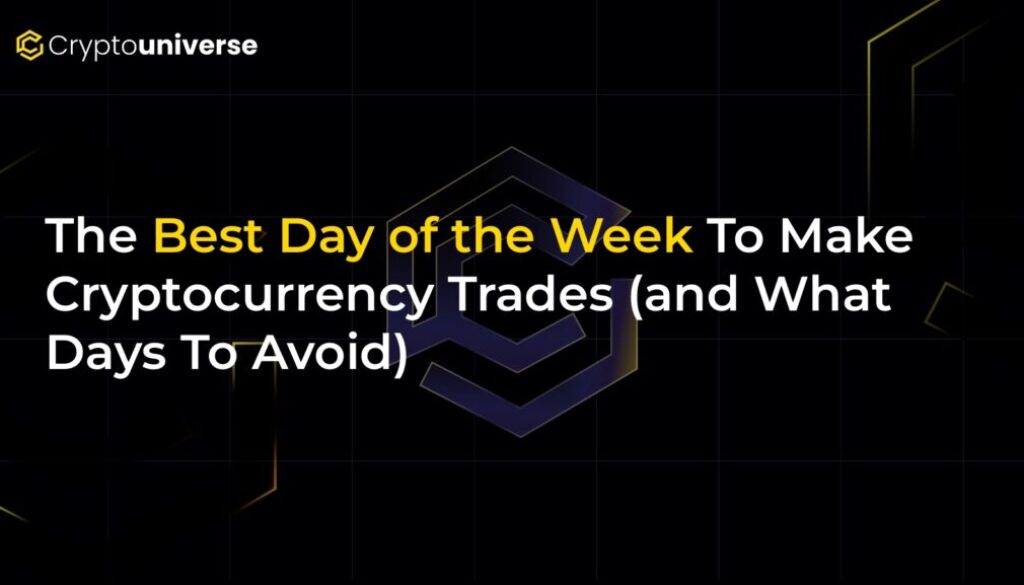The Best Day of the Week To Make Cryptocurrency Trades (and What Days To Avoid)

The 24/7 Dilemma: When is the Best Time to Trade Crypto?
The cryptocurrency market never sleeps. Unlike traditional stock markets with set opening and closing bells, crypto trades around the clock, across every time zone. This 24/7 access is a massive draw for traders, but it also presents a significant challenge: with a market that’s always on, how do you know when to show up?
While there’s no magic formula that guarantees profit, years of market data have revealed distinct patterns in trading volume and price action. By understanding these rhythms, you can strategically time your trades to capitalize on market momentum. This guide will break down the
The Weekend Wind-Down: A Time for Strategy, Not Trades
For many active traders, Saturday and Sunday are considered off-limits. Trading volume typically dips significantly over the weekend as institutional players and a large portion of retail traders step away from their screens.
However, this doesn’t mean the weekend is unproductive. Proactive traders use this quiet time for crucial preparation:
- Reviewing Past Trades: Analyze what went right and wrong during the previous week to refine your strategy.
- Studying Charts: Conduct technical analysis without the pressure of a live, fast-moving market.
- Checking Market Bias: Gauge the overall market sentiment to form a plan for the upcoming week.
- Monitoring News: Catch up on industry news and economic events that could impact the market.
While you can trade on weekends, be aware that lower liquidity can sometimes lead to sharp, unexpected price swings (volatility) caused by automated trading bots that dominate the quiet market.
Is Monday the Best Day to Buy Crypto?
After a slow weekend, the market often wakes up on Monday. Many analysts suggest that Monday can be the best day of the week to buy cryptocurrency for a long-term portfolio. The logic is that prices may be slightly suppressed after the weekend lull, offering a potential discount as trading volume begins to ramp up globally.
It’s important to distinguish this from active trading. If your goal is to accumulate assets for the long haul, looking for entry points on a Monday could be a sound strategy. For active traders looking to profit from short-term movements, the real action starts a little later.
The Mid-Week Momentum: Prime Time for Active Trading
The consensus among seasoned traders is that the middle of the week—Tuesday, Wednesday, and Thursday—is the sweet spot for active trading. During these days, the global market is fully engaged, leading to the highest levels of liquidity and trading volume.
Why does this matter?
- High Liquidity: With more buyers and sellers in the market, you can execute trades quickly and at more stable prices, with tighter spreads (the difference between the buy and sell price).
- Higher Volatility: Increased activity often means more significant price movements, which creates more opportunities for traders to profit from.
- Market Psychology: Traders are often ramping up on Mondays and winding down on Fridays, making the mid-week period the peak of focus and participation.
Unlocking the Clock: Finding the Most Active Trading Hours
Beyond the day of the week, the specific time of day is critical. The highest volume occurs when major global financial markets overlap. The three main sessions to watch are:
- Asian Session: Roughly 12:00 AM to 9:00 AM UTC
- European (London) Session: Roughly 8:00 AM to 5:00 PM UTC
- North American (New York) Session: Roughly 1:00 PM to 10:00 PM UTC
The most powerful trading window is the London-New York overlap, which occurs between 1:00 PM and 5:00 PM UTC (or 9:00 AM to 1:00 PM EST). During these four hours, two of the world’s largest financial centers are active, driving massive liquidity and volatility into the crypto market. Many day traders in the US focus their efforts exclusively on this morning session.
Beyond the Clock: External Forces That Drive Crypto Prices
Timing patterns are a useful guide, but they can be instantly overridden by external events. A savvy trader always keeps an eye on these factors:
- Major News Events: Announcements about regulations, major partnerships, or technological breakthroughs can send prices soaring or tumbling, regardless of the day.
- The Economic Calendar: Don’t trade in a vacuum. Major economic data releases, such as inflation reports (CPI) or central bank interest rate decisions (FOMC), have a powerful ripple effect on all financial markets, including crypto.
- Social Media and Hype: In the world of crypto, a single tweet from a major influencer can trigger a frenzy of buying or selling. Always be aware of the prevailing narrative.
Conclusion: A Tool, Not a Rule
Understanding the best days and times to trade can give you a significant edge. By aligning your activity with periods of high liquidity and volume, you increase your probability of success.
Here’s a quick summary:
- Weekends: Best for planning, learning, and analysis.
- Mondays: Often a good day for buying and accumulating for the long term.
- Tuesdays, Wednesdays, Thursdays: The prime days for active day trading due to high volume and liquidity.
- London/New York Overlap (1 PM – 5 PM UTC): The golden hours for peak market activity.
Ultimately, these patterns are a tool, not a rigid rule. The most important factor for success is a well-defined trading strategy, disciplined risk management, and a deep understanding of your own goals. Use this guide to trade smarter, not just harder.


